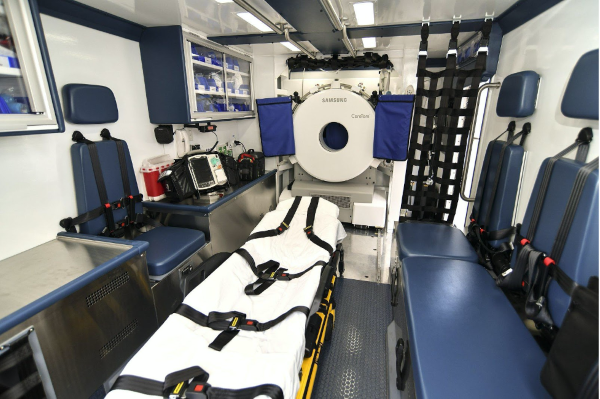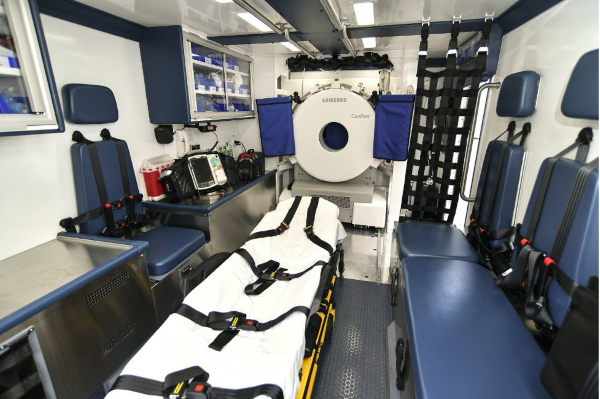Prehospital imaging modalities have the potential to change the way we deliver prehospital care.
Emergency department goals such as reducing door-to-thrombolytic-therapy times have led to increased focus on equipping EMS with portable imaging modalities. Increased ED utilization has led to innovative use cases for prehospital ultrasound to better triage patients to the appropriate destination and avoid unnecessary transfers. However, the cost effectiveness has yet to be seen.
Review of Literature
Mobile Stroke Units May Reduce The Time To Treatment But The Clinical Significance May Not Justify The Cost
This prospective study compares randomly allocated periods with and without stroke emergency mobile unit availability. The mobile Stroke Unit (MSU) results were measured against standard ED imaging for diagnosis and treatment of patients with stroke symptoms:
- The time to thrombolytic therapy administration using a mobile stroke unit has been decreased. Decreased door to tPA times varied from 15-42 minutes, depending on the hospital location. Hospitals in urban locations did not decrease their time as much as rural locations.
- A mobile stroke vehicle shown in the figure below contains an onboard CT scanner, POC lab, telemedicine capability with a paramedic, radiology technician, and neurologist on board at all times. Each unit cost between $600,000 to $1,000,000 each, with an annual operating cost at $950,000 to $1,200,000 (for 12 hours each day).1 In comparison, the annual operating cost for a traditional ambulance is roughly $745,000.1
- Most patients encountered by the mobile stroke units were not not candidates for intravenous thrombolytic therapy. Patients were suffering a transient ischemic attack (TIA) and would have gotten better without treatment.2
- The demand for MSU may not be sustainable. The run-in phase provided a tPA treatment rate of 1.5 patients per week.3
Authors concluded mobile stroke units can decrease the time to thrombolytic therapy but at a potentially prohibitive expense.

Impact Of Mobile Stroke Units In Rural And Underserved Settings
This study looked to incorporate Mobile Stroke Units (MSU) in rural and underserved settings. The intravenous and endovascular treatment rates were compiled from Medicare claims data, and geographic access of the U.S. population was compiled from the U.S. census data:
- The proportion of the population with primary stroke center access in ≤60 minutes was 66% for ground access and 91% by air, leaving a significant portion of the population without sufficient access.4
- In the past 10 years, tPA use in hospitals has dramatically increased. However, rural hospitals are behind at 1.59% compared to urban hospitals close to 5%.5 This discrepancy can be visualized in the heat maps below.
- MSUs may be a valuable resource to rural and remote settings where patients may not have easy access to in-hospital stroke care.
- Hospitals equipped with comprehensive stroke care can effectively increase their catchment area by 250 km radius surrounding a comprehensive stroke center with a hybrid ground-air MSUs.5
- MSU cost-effectiveness may be improved by substituting onboard physicians for telemedicine-linked remote experts.
Perception of Prehospital Imaging
This study aimed to explore the views of embedding prehospital ultrasound by emergency medicine practitioners. Semi-structured interviews were conducted with four consultant physicians and eight paramedics. The analysis used hierarchical axial coding and normalization process theory as a framework:6
- The prospect of utilizing prehospital ultrasound evoked a polarizing response from emergency physicians and paramedics:
- Paramedics appreciated the increased decision-making support and ability to identify life-threatening occult conditions in their scope of work.
- Physicians expressed concerns in proper training and potential misinterpretation by the user.
- Both groups were not sure how prehospital ultrasound would benefit patients in urban areas close to the emergency department or rural areas where serious emergencies are infrequent.
Prehospital Ultrasound In Detecting Stroke
Although a mobile stroke unit outfitted with a CT scanner has shown shorter time to thrombolytic therapy, it may be out of most hospitals' budgets. This single-site prospective study looked to see if a portable ultrasound with transcranial duplex can be a cheaper alternative:
- The transcranial ultrasound in the field showed 98% accuracy in detecting major occlusion within the MCA and ACA compared to traditional in-hospital imaging modalities.7
- 42% of the transcranial ultrasound examinations were performed en route to the hospital, alleviating concerns in delayed prehospital time.7
- The accuracy of stroke diagnosis is dependent on the user's clinical acumen and ability to perform a transcranial ultrasound exam. However, proper training and telemedicine support by a stroke neurologist may make it feasible for broader applications.
Prehospital Ultrasound In Trauma
This prospective observational study looked to compare the quality, indication criteria, and use cases for the eFAST protocol in the prehospital and in-hospital setting.9
- The most common indications for prehospital emergency ultrasound was dyspnea (38.4%), cardiac arrest (17.2%), fall (12.1%), and high-speed trauma (11.1%)
- In one-hird of patients, the destination or priority of the patient was altered based on ultrasound findings.
- Changes in patient management occurred in 49.5% of patients with ultrasound use.
- The biggest barrier this study found was training the rescue physicians to perform the ultrasound exam in under 1-2 minutes.
The authors of this study concluded the applications for prehospital ultrasound should not be used for complete diagnosis or treatment, but to improve the management plan or alter the destination of care without prolonging mission time. Diagnosis of significant pathology that prolongs the transport time should be addressed in the hospital.
Summary of Literature
Advancements in medical imaging technology has stretched the scope of prehospital care. CT scanners, once available only to academic institutions, are being retrofitted into ambulances. Ultrasound machines big enough for wheels can now be carried in a white coat pocket for a fraction of the cost. Despite these technological innovations, the financial barriers may not justify the cost of implementing these modalities in prehospital care. Rather than widespread use, evidence suggests that these resources should be utilized in specific situations (ie, in the setting of rural or critical access care) to improve patient management and/or optimize ED utilization. Whether these tools can be utilized to improve patient outcomes, or lead to cost savings, is yet to be fully evaluated.
Looking Forward/What's Next
Currently the BESTMSU Trial is underway. This study aims to evaluate the cost efficiency data comparing mobile stroke units to standard management. Results are expected in July 2021 and may alter the landscape of pre-hospital imaging.
Other Recommended Literature
- Taylor J, Mclaughlin K, Mcrae A, et al. Use of prehospital ultrasound in North America: A survey of emergency medical services medical directors. BMC Emerg Med. 2014;14:6.
- Martinez-Gutierrez JC, Chandra RV, Hirsch JA, et al. Technological innovation for prehospital stroke triage: ripe for disruption. J Neurointerv Surg. 2019;11:1085-1090.
- Roantree RA, Furtado C, Welch K, Lambert M. EMS Ultrasound Use. StatPearls, StatPearls Publishing, 19 September 2020.
EMRA Administration & Operations Committee Links, Guides and Opportunities
- Check out what’s happening with our group at the EMRA A&O landing page.
- Looking to gain a mastery of this and other relevant operational knowledge? Consider applying for EMRA's ED Directors Academy scholarship.
References
- Bukata R. Are mobile CT stroke units worth the price tag? Emergency Physicians Monthly. 2017;(1):15–18.
- Saver J, et. al. Time to treatment with intravenous tissue plasminogen activator and outcome from acute ischemic stroke. JAMA. 2013;309(23):2480.
- Bowry R, Parker S, Rajan SS, et al. Benefits of Stroke Treatment Using a Mobile Stroke Unit Compared With Standard Management: The BEST-MSU Study Run-In Phase. Stroke. 2015;46(12):3370-3374.
- Adeoye O, Albright KC, Carr BG, Wolff C, Mullen MT, Abruzzo T, et al. Geographic access to acute stroke care in the United States. Stroke. 2014;45:3019–24.
- Mathur S, Walter S, Grunwald IQ, Helwig SA, Lesmeister M, Fassbender K. Improving Prehospital Stroke Services in Rural and Underserved Settings With Mobile Stroke Units. Front Neurol. 2019;10:159.
- Marsh-Feiley G, Eadie L, Wilson P. Paramedic and physician perspectives on the potential use of remotely supported prehospital ultrasound. Rural Remote Health. 2018;18(3):4574.
- Herzberg M, Boy S, Holscher T, et al. Prehospital stroke diagnostics based on neurological examination and transcranial ultrasound. Crit Ultrasound J. 2014;6(1):3.
- Zavadsky M. Part 1: Economic Models for EMS 3.0. J EMS. Published September 13, 2016.
- Scharonow M, Weilbach C. Prehospital point-of-care emergency ultrasound: a cohort study. Scand J Trauma Resusc Emerg Med. 2018;26:49.



